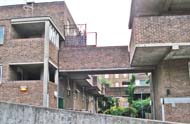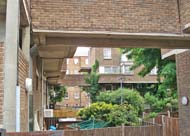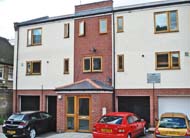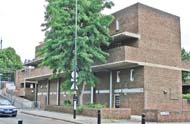Her Majesty's Hospital
for Sick Children
for Sick Children
13-19 Stepney Causeway, Tower Hamlets, E1 0JW
Medical dates:
Medical character:
Acute
Built to mark Queen Victoria's Golden Jubilee in 1887, Her Majesty's Hospital for Sick Children opened in January 1889 with 84 beds for the care of the poor children of Stepney. Established by Dr Thomas Barnardo (1845-1905), it was one of the first hospitals to specialise in children's disease and, indeed, was the largest children's hospital in London at that time.
The plain brick 4-storey building was erected on the site of Nos. 13, 15, 17 and 19 Stepney Causeway at a cost of £7,800. The ground, first, second and third floors contained six general wards, an isolation ward and a convalescent ward, as well as accommodation for the Matron and her nursing staff. There was also an operating theatre. The resident physician's apartment opened cabin-like onto an asphalted flat roof, which was used as an open-air exercise yard by convalescent patients. The basement, which was connected to the Boys' Home opposite by a tunnel, contained a kitchen and its pantries, a dispensary and a mortuary.
The Hospital had a low mortality rate because of its high standards of hygiene.
By the turn of the century Dr Barnardo's Homes occupied one whole side of the Stepney Causeway, from Commerical Road to the railway line.
In 1903 No. 30, on the other side of the railway, was purchased for use as an isolation hospital for children with infectious diseases, ophthalmia (conjunctivitis) and ringworm.
By 1905 the Hospital had 90 cots and beds, which were always occupied. Sick babies and toddlers had their own ward, furnished with red and white striped quilts and equipped with toys.
The Hospital closed in 1922 as most of the children had moved to new accommodation in the William Baker Technical School in Hertford. Its work was taken over by the John Capel Hanbury Hospital in the Boys' Garden City, Woodford Bridge, Essex.
Present status (June 2008)
The building was renamed Barnardo House and was used as office accommodation until 1969.
The area has since been redeveloped and the Hospital site is now part of the Pitsea Estate, a housing complex. Barnardo Street runs into Stepney Causeway.


Nos. 13-19 Stepney Causeway in the Pitsea Estate.

The terraced building which includes the site of No. 18 (once the Children's Home established by Dr Barnardo).


The former Hospital site seen from the corner of Stepney Causeway and Cable Street (left). Signage on Cable Street for the street numbering arrangement (right).

Ground plan for the Pitsea Estate.
(Author unstated) 1905 Her Majesty's Hospital at Stepney. British Journal of Nursing, 30th September, 279.
Barnado Mrs, Marchant J 1907 Memoirs of the late Dr Barnardo. London, Hodder & Stoughton.
http://canadianbritishhomechildren.weebly.com
www.barnardos.org.uk
www.gettyimages.co.uk
www.goldonian.org
www.happywarrior.org
Return to home page